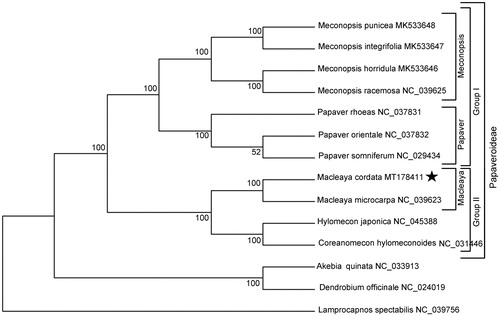Abstract
Macleaya cordata (Willd.) is a perennial herb with significant antimicrobial and anti-inflammatory activities. In this study, we report the complete chloroplast genome sequence of M. cordata. The total genome size was 163,179 bp in length, containing two inverted repeated (IR) regions of 28,329 bp each, a large single copy (LSC) region of 87,933 bp and a small single copy (SSC) region of 18,588 bp. The genome contains 114 genes, including 79 protein genes, 4 rRNA genes, 28 tRNA genes and 3 pseudo genes. The overall GC content of M. cordata is 38.59%, with the highest GC content of 42.79% in IR region. A total of 49 simple sequence repeats are identified in the cp genome of M. cordata. Phylogenetic analysis demonstrated that M. cordata clustered together with M. microcarpa, further forming a monophyletic group with the genuses Hylomecon and Coreanomecon. This work provides basic genetic resources for developing robust markers and investigating the population genetics diversities for this famous medicinal species.
Macleaya cordata is a medicinal plant species from the subfamily Papaveroideae, which is typically prescribed as a traditional antibacterial medicine (Sai et al. Citation2015). This species has been used as a natural additive in livestock because of its antimicrobial, anti-fungal and anti-inflammatory activity (Li et al. Citation2018). Furthermore, M. cordata provides a safe resource for the bioactive compound sanguinarine, which could potentially improve the growth performance and intestinal morphology of early-weaned piglets via modifying the intestinal luminal environment (Chen et al. Citation2018). The extract of M. cordata plays a preventative role with respect to Escherichia coli infection (Guan et al. Citation2019). The complete chloroplast genome information would contribute to the species identification and cultivation research of this important medicinal plant. Here, we report the complete chloroplast genome of M. cordata to provide a genomic resource for molecular marker development and clarify the phylogenetic position of this plant within the subfamily Papaveroideae.
The sample of Macleaya cordata was collected from Fuyang area of Zhejiang Province (30°05’2.4”N, 119°53’20.4”E) and deposited in the collection center of Zhejiang Chinese Medical University with the specific identifying number of BLH-1932. Total genomic DNA was extracted and sequenced using the Illumina Hiseq Platform according to the previous reprot (Ying et al. Citation2019; Gao et al. Citation2020). The chloroplast genome of M. cordata was assembled by metaSPAdes with the chloroplast sequence of M. microcarpa as reference (Nurk et al. Citation2017). The chloroplast was annotated using GeSqe and further confirmed by BLAST (Tillich et al. Citation2017). The complete cp genome of M. cordata was submitted to GenBank with the accession number of MT178411.
The length of the complete chloroplast genome sequence of M. cordata was 163,179 bp, with a large single copy (LSC) region of 87,933 bp, a small single copy (SSC) region of 18,588 bp, and two separated inverted repeated (IR) regions of 28,329 bp each. A total of 114 genes were identified in the cp of M. cordata, including 79 protein-coding genes, 28 tRNA genes, 4 rRNA genes and 3 putative pseudo genes. The overall GC content was 38.59%, and the corresponding contents for LSC, SSC and IR regions were 37.04%, 33.12% and 42.79%, respectively. The genome included 19 duplicated genes in the IR region and exhibited 51.1% protein-coding sequences. Moreover, a total of 49 small single repeats (SSR) are identified in the cp of M. cordata, ranging from 10 bp to 36 bp.
The complete genome sequences of M. cordata and other 17 representative species from the subfamily Papaveroideae were analyzed using MEGA 7.0 by maximum-likelihood (ML) method to confirm its phylogenetic position. The result demonstrated that a sister relationship between M. cordata and M. microcarpa, indicating a close genetic relationship between the two species (). Furthermore, the monophyletic group of Macleaya displayed a sister-relationship with the combined clade of genuses Hylomecon and Coreanomecon, forming the Group II in the the subfamily Papaveroideae (). These results would contribute the development of molecular markers and understanding of evolutionary history and cultivation strategy for Macleaya cordata.
Figure 1. ML phylogenetic tree analysis of Macleaya cordata and other representative Papaveroideae plants based on the complete chloroplast genome sequences. Numbers on the nodes are bootstrap values from 100 replicates. The GenBank accession numbers were listed following the species name. The species of Lamprocapnos spectabilis, Akebia quinata and Dendrobium officinale were used as the outgroup species.

Disclosure statement
No potential conflict of interest was reported by the author(s).
Additional information
Funding
References
- Chen J, Kang B, Zhao Y, Yao K, Fu C. 2018. Effects of natural dietary supplementation with Macleaya cordata extract containing sanguinarine on growth performance and gut health of early-weaned piglets. J Anim Physiol Anim Nutr. 102(6):1666–1674.
- Gao C, Wang Q, Ying Z, Ge Y, Cheng R. 2020. Molecular structure and phylogenetic analysis of complete chloroplast genomes of medicinal species Paeonia lactiflora from Zhejiang Province. Mitochondrial DNA Part B. 5(1):1077–1078.
- Guan G, Ding S, Yin Y, Duraipandiyan V, Al-Dhabi NA, Liu G. 2019. Macleaya cordata extract alleviated oxidative stress and altered innate immune response in mice challenged with enterotoxigenic Escherichia coli. Sci China Life Sci. 62(8):1019–1027.
- Li B, Zhang JQ, Han XG, Wang ZL, Xu YY, Miao JF. 2018. Macleaya cordata helps improve the growth-promoting effect of chlortetracycline on broiler chickens. J Zhejiang Univ Sci B. 19(10):776–784.
- Nurk S, Meleshko D, Korobeynikov A, Pevzner PA. 2017. metaSPAdes: a new versatile metagenomic assembler. Genome Res. 27(5):824–834.
- Sai CM, Li DH, Xue CM, Wang KB, Hu P, Pei YH, Bai J, Jing YK, Li ZL, Hua HM. 2015. Two pairs of enantiomeric alkaloid dimers from Macleaya cordata. Org Lett. 17(16):4102–4105.
- Tillich M, Lehwark P, Pellizzer T, Ulbricht-Jones ES, Fischer A, Bock R, Greiner S. 2017. GeSeq - versatile and accurate annotation of organelle genomes. Nucleic Acids Res. 45(W1):W6–W11.
- Ying Z, Wang Q, Yu S, Liao G, Ge Y, Cheng R. 2019. The complete chloroplast genome sequence and phylogenetic analysis of the medicinal plant Lysimachia hemsleyana. Mitochondrial DNA B. 4(2):3878–3879.
